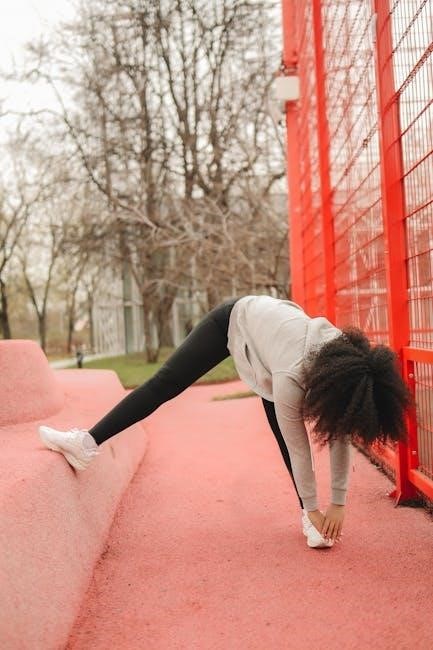A proper warm-up is essential before running, preparing the body for physical activity․ It involves dynamic stretches and light cardio to prevent injuries and enhance performance․ A 5-10 minute routine ensures muscles are ready, improving circulation and flexibility for a safer, more effective run․
1․1 Importance of Warming Up
Warming up is essential before running, as it increases core and muscle temperature, enhancing performance and reducing injury risk․ It improves blood flow and oxygen delivery, preparing the body for physical exertion․ Dynamic stretches and light cardio activate the nervous system, improving coordination and muscle activation․ A proper warm-up also mentally prepares runners, ensuring focus and readiness for their workout․
1․2 Brief Overview of Running Warm-Ups
A running warm-up typically lasts 5-10 minutes, combining dynamic stretches and light cardio․ It includes exercises like high knees, leg swings, and butt kicks to prepare the body for movement․ The goal is to increase blood flow, improve circulation, and enhance flexibility, ensuring muscles are ready for physical activity while reducing injury risk and improving overall performance․
Benefits of a Proper Warm-Up Routine
A proper warm-up prepares the body for exercise, improving circulation and flexibility while reducing muscle stiffness․ It enhances performance by increasing oxygen delivery to muscles․
Regular warm-ups also lower injury risk and accelerate recovery, ensuring a safer and more effective workout experience for runners of all levels and distances․
2․1 Injury Prevention
A proper warm-up significantly reduces the risk of injuries by increasing muscle flexibility and blood flow․ Dynamic stretches and light cardio prepare the body for physical demands, lowering the chance of strains, sprains, and overuse injuries․ This is particularly important for runners, as it helps avoid common issues like shin splints and muscle pulls, ensuring a safer and more enjoyable running experience․
2․2 Improved Performance
A proper warm-up enhances running performance by preparing muscles for exertion․ Dynamic stretches and light cardio increase blood flow and oxygen delivery, optimizing muscle function․ This preparation boosts power, speed, and endurance, allowing runners to perform at their best while maintaining efficiency and reducing fatigue during the workout․
2;3 Enhanced Blood Flow and Oxygen Delivery
A proper warm-up increases blood flow and oxygen delivery to muscles, preparing them for physical demands․ Dynamic exercises like high knees and butt kicks raise core temperature, enhancing circulation․ Improved oxygen supply boosts energy production, reducing fatigue and optimizing performance during runs․

Key Components of a Running Warm-Up
A running warm-up includes dynamic stretching, light cardio, and muscle activation drills․ These components prepare the body for exercise by increasing flexibility, heart rate, and muscle engagement, ensuring a safe and effective transition into running․
3․1 Dynamic Stretching
Dynamic stretching involves active movements that mimic running, such as high knees, butt kicks, and leg swings․ These exercises prepare the muscles for activity by improving flexibility, range of motion, and blood flow․ Unlike static stretches, dynamic movements keep the body in motion, reducing stiffness and injury risk while enhancing performance; They are essential for a runner’s warm-up routine․
3․2 Light Cardiovascular Exercises
Light cardiovascular exercises, such as jogging in place or brisk walking, are crucial for gradually increasing heart rate and blood flow․ These activities prepare the body for more intense running by raising core temperature and enhancing oxygen delivery to muscles․ Spending 5-10 minutes on light cardio ensures a smooth transition from rest to activity, reducing injury risk and improving performance․

3․4 Muscle Activation Drills
Muscle activation drills, such as glute bridges and planks, engage key muscle groups to improve running efficiency and posture․ These exercises target the core, glutes, and legs, ensuring proper muscle firing patterns․ Activating these areas before running enhances stability, reduces injury risk, and prepares the body for optimal performance during the workout․
Structuring Your Warm-Up Routine
A well-structured warm-up routine allocates time for dynamic stretches, light cardio, and muscle activation, focusing on major muscle groups to optimize performance and prevent injuries․
4․1 Time Allocation
A proper warm-up typically lasts 5-10 minutes, ensuring enough time to prepare the body without fatiguing muscles․ Allocate 2-3 minutes for light cardio, followed by dynamic stretches and muscle activations, distributing time evenly to major muscle groups for optimal preparation and injury prevention, while enhancing performance capabilities during the run․
4․2 Focus on Major Muscle Groups
Targeting major muscle groups like legs, hips, and core ensures effective preparation for running․ Focus on exercises such as lunges, leg swings, and high knees to activate these areas․ Incorporate arm circles and torso movements for upper body engagement․ This balanced approach enhances flexibility, strength, and coordination, reducing injury risk and improving overall performance during the run․
Specific Warm-Up Exercises for Runners
Key exercises include high knees, butt kicks, leg swings, lunges, and arm circles․ These movements target major muscle groups, improving flexibility and preparing the body for running․
5․1 High Knees
High knees are a dynamic exercise where runners lift their knees toward their chest while maintaining a steady pace․ This movement enhances hip mobility, activates the core, and improves running stride․ It mimics the running motion, preparing the legs and cardiovascular system for the workout ahead․ Incorporating high knees into a warm-up routine helps boost flexibility and coordination, ensuring a smoother transition into running․
5․2 Butt Kicks
Butt kicks involve bending the knees and bringing the heels toward the buttocks while moving forward․ This dynamic exercise targets the hamstrings, calves, and hip flexors, improving flexibility and stride efficiency․ It mimics the backward motion of running, helping to prepare the lower body for the workout․ Regular practice reduces injury risk and enhances overall running performance․
5․3 Leg Swings
Leg swings are a dynamic stretch that targets the hamstrings, quads, and hip flexors․ Stand tall, swing one leg forward and backward, then switch․ This exercise improves flexibility, range of motion, and prepares the legs for running․ It enhances stride efficiency and reduces the risk of injury, making it a valuable addition to any pre-run warm-up routine․
5․4 Lunges
Lunges are a dynamic stretch that targets the quadriceps, hamstrings, and hip flexors․ Step forward with one leg, lower your body until both knees bend at 90 degrees, then return․ This exercise improves flexibility, range of motion, and strengthens the muscles around the knees, reducing injury risk․ Proper form is essential to avoid strain and maximize benefits for running performance․
5․5 Arm Circles
Arm circles are a simple yet effective dynamic stretch for the shoulders and upper body․ Extend your arms out to the sides and make small circles, first forward and then backward․ This movement loosens the shoulder muscles, improves circulation, and reduces stiffness․ Regular arm circles enhance flexibility and prepare the upper body for the repetitive motion of running․
Dynamic vs․ Static Stretching
Dynamic stretching involves active movements like arm circles and leg swings, preparing muscles for activity․ Static stretching holds poses, better suited for post-workout relaxation․ Dynamic stretching is preferred for warm-ups as it enhances flexibility and readies the body for movement, reducing injury risk during exercise․
6․1 Differences Between the Two
Dynamic stretching involves active, moving stretches like leg swings and arm circles, raising heart rate and preparing muscles for activity․ Static stretching holds poses, targeting specific muscles for relaxation․ Dynamic stretching is ideal for warm-ups, improving flexibility and reducing injury risk, while static stretching is better suited for post-workout recovery and muscle relaxation․
6․2 Why Dynamic Stretching is Preferred
Dynamic stretching is preferred as it prepares the body for movement by increasing blood flow, muscle temperature, and flexibility․ It mimics running motions, improving muscle activation and coordination․ Unlike static stretching, dynamic stretching enhances performance and reduces injury risk by engaging the nervous system and maintaining muscle elasticity during exercise․

Warm-Up Exercises for Specific Running Needs
Targeted warm-ups address specific running challenges, such as preventing IT band syndrome and reducing plantar fasciitis risk through tailored exercises that strengthen and stabilize key areas․
7․1 Preventing IT Band Syndrome
Exercises like side lunges and leg swings target the IT band, strengthening surrounding muscles and improving hip mobility․ Dynamic stretches, such as leg swings, help reduce tightness and inflammation, lowering the risk of IT band syndrome during runs․ Incorporating these into your warm-up routine can significantly enhance comfort and performance․
7․2 Reducing Risk of Plantar Fasciitis
Target the plantar fascia and Achilles tendon with calf stretches and heel raises․ Dynamic exercises like toe walks and foot rolls can reduce muscle tension․ Incorporating these into your warm-up helps prevent tightness and inflammation, lowering the risk of plantar fasciitis․ Proper footwear and gradual intensity increases also support long-term foot health during running․
Full-Body Warm-Up Routine
A full-body warm-up combines dynamic stretching with core activation to prepare muscles for running, improving flexibility and circulation while reducing injury risk․
8․1 Core Activation
Core activation exercises prepare your torso muscles for running, improving posture and stability․ Plank variations, bird dogs, and pelvic tilts engage the abdominals and lower back, enhancing balance and reducing injury risk․ These simple movements require minimal equipment and are essential for maintaining proper form during runs, ensuring a strong and stable foundation for optimal performance․
8․2 Upper Body Movements
Upper body movements are crucial for balance and posture while running․ Arm circles, shoulder rolls, and side stretches improve flexibility and circulation․ These exercises prepare the muscles for movement, enhancing overall running efficiency and reducing the risk of injury․ Incorporating dynamic stretches like arm swings ensures your upper body is ready to support your lower body during the run․

Common Mistakes to Avoid
Skipping the warm-up entirely and rushing through stretches are common errors․ Overstretching or holding stretches too long can reduce performance and increase injury risk for runners․
9․1 Rushing the Warm-Up
Rushing through a warm-up can leave muscles underprepared, increasing injury risk․ A proper warm-up should last 5-10 minutes, incorporating dynamic stretches and light cardio to enhance circulation and flexibility, ensuring the body is ready for running․ Skipping or speeding through this process can lead to poor performance and heightened susceptibility to common running injuries like muscle strains or shin splints․
9․2 Overstretching or Holding Stretches Too Long
Overstretching or holding stretches too long can lead to muscle weakness and reduced power, which is counterproductive for running․ Dynamic stretches are preferred as they mimic running movements, improving flexibility without the risks of overstretching․ This approach ensures muscles are prepared for activity while maintaining strength and reducing injury risk during runs․
Sample Warm-Up Routine
A 5-10 minute dynamic warm-up includes high knees, butt kicks, leg swings, and arm circles․ These exercises prepare the body for running by enhancing blood flow and flexibility, ensuring a safe and effective workout․
10․1 5-10 Minute Dynamic Warm-Up Plan
Start with 2 minutes of light jogging or walking․ Follow with 30 seconds of high knees, butt kicks, and leg swings to activate the lower body․ Transition into arm circles and torso twists for upper body mobility․ Conclude with 2 minutes of dynamic stretches like lunges and hip openers to enhance flexibility and prepare muscles for running․ This routine ensures a safe and effective transition into your run․

Incorporating Warm-Up into Your Training Schedule
Consistency is key; include a dynamic warm-up in every training session to enhance performance and reduce injury risk, ensuring long-term progress and overall running health․
11․1 Consistency is Key
Regularly incorporating a warm-up into your training schedule is crucial for optimal performance and injury prevention․ Aim to perform a dynamic warm-up before every run, focusing on muscle activation and light cardio․ Consistency ensures improved circulation, flexibility, and prepares your body for physical demands, reducing the risk of injuries and enhancing overall running efficiency over time․

A proper warm-up is essential for safe and effective running․ It prevents injuries, improves performance, and enhances overall running efficiency․ Consistency is key to long-term benefits․
12․1 Summary of Benefits
A proper warm-up enhances running performance by improving flexibility, balance, and muscle activation․ It reduces the risk of injuries through dynamic stretching and increased blood flow․ Regular warm-ups also boost endurance, reduce muscle soreness, and prepare the cardiovascular system for intense workouts․ Consistency is key to reaping these benefits and optimizing overall running efficiency․

12․2 Encouragement to Prioritize Warm-Ups
Consistently incorporating warm-ups into your routine is crucial for maximizing performance and longevity as a runner․ By dedicating just 5-10 minutes to dynamic stretches and light exercises, you safeguard against injuries, enhance endurance, and elevate overall running efficiency․ Prioritizing warm-ups ensures your body is prepared for the demands of running, helping you achieve your goals and maintain long-term health․